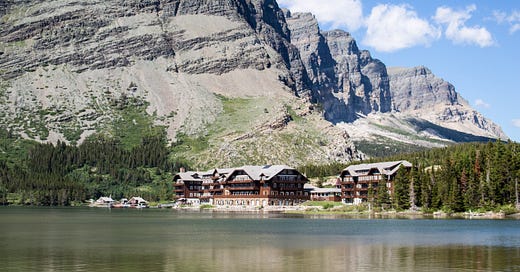Profit in the Parks: How Railroads Shaped the National Parks for the Wealthy
Private interests capitalized on the first national parks, encouraging wealthy American to "See America First" instead of traveling to Europe.
The origins of America’s national parks are often celebrated as a democratic triumph—public lands preserved for all to enjoy. But the reality is much more complex.
As profit appears to influence many policy proposals and decisions nowadays, the potential privatization of (parts of) national parks and public lands is an increasingly serious concern.
Attempts to transfer federal lands to states, or sell sections of public lands to private interests occur virtually on a daily basis. Often behind closed doors, or in the middle of the night, away from public input or feedback.
While this threat is very much real—and national parks are not immune—it’s worth taking a look at how America’s world-class National Park System actually came into existence.
Who were the people pushing for the creation of national parks?
Who were the people who stood to gain the most from protected places like Yellowstone, Glacier, and Grand Canyon?
Who were the people funding and promoting access to national parks?
While the idea of setting aside wilderness “for the benefit and enjoyment of the people” was revolutionary in 1872, the early access to national parks was anything but egalitarian. In fact, much of the development and popularization of the parks was driven by private railroad companies with an eye on the nation’s elite.
By marketing the parks as luxurious retreats and building upscale lodges accessible by rail, the railroad companies catered to affluent tourists and shaped the national park experience in ways that excluded most Americans.
The Preservation Ethos Meets Corporate Strategy
The national park concept emerged from shifting 19th-century attitudes toward nature.
Influenced by the Romantic movement, transcendentalism, and the art of the Hudson River School, many Americans—particularly those in the urban elite—began to see wilderness not just as a resource to exploit, but as a national treasure to be revered and preserved.
This ideological foundation led to the 1864 Yosemite Grant and, more significantly, to the establishment of Yellowstone National Park in 1872.
Influential artists like photographer William Henry Jackson and, particularly, painter Thomas Moran (who was a member of the Hudson River School) produced beautiful works featuring Yellowstone, boosting popularity and admiration of western landscapes among East Coast Americans.
On March 1, 1872, Yellowstone became the world’s first national park, protected by the federal government as a place for recreation and wonder. But visiting it required time, money, and effort—resources largely limited to the wealthy.
The railroads quickly recognized the economic opportunity in promoting these newly protected landscapes, but they didn’t promote them for all Americans. They designed an experience tailored to the upper class, who had the means to travel long distances, take extended vacations, and afford high-end accommodations.
The modern meaning of the word “vacation” dates from this very period. In the late 19th century, a “vacation” became to Americans what a “holiday” was to the British —“a period spent away from home or business in travel or recreation.”
This coincided with the Second Industrial Revolution, which ran from 1870 to 1914, and overlapped uncannily with the creation of the first national parks, all of which were in the West:
Yellowstone (1872)
Sequoia (1890)
Yosemite (1890)
Mount Rainier (1899)
Crater Lake (1902)
Wind Cave (1903)
Mesa Verde (1906)
Glacier (1910)
However, the privilege of “vacationing” was exclusively available to wealthy people. In the United States, the first national parks played a huge role in the fairly new concept of “vacations” enjoyed by the rich.
A Business Model Built on Affluence
The Northern Pacific Railroad, one of the first companies to access Yellowstone National Park, exemplified this strategy. In the 1880s, it extended a rail line to Livingston, Montana, which reached Gardiner, just outside Yellowstone’s northern entrance, in 1902.
Keep reading with a 7-day free trial
Subscribe to The National Parks Experience to keep reading this post and get 7 days of free access to the full post archives.




